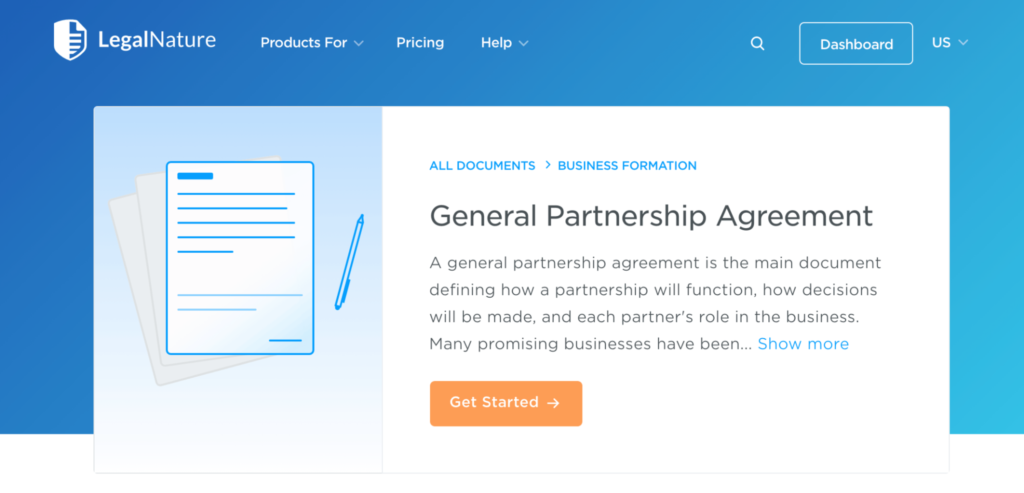It’s a dream for many entrepreneurs to start a business with a friend, family member, or colleague. But just because you know somebody personally, it doesn’t always mean that the business relationship will go smoothly.
Forming a business partnership can formalize the relationship and provide clarity on how the partners will operate.
Lots of people have misconceptions about partnerships and how they work, which is why we created this guide. If you’re starting a company with one or more partners, a formal business partnership can help save you from many hassles and headaches down the road.
What is a Business Partnership?
Business partnerships are legal relationships between two or more people. The partners both invest money into the company and share profits and losses.
Partnerships alone are not always viewed as separate entities from the business owners. Business partnerships are similar to sole proprietorships in the sense that the partnership isn’t taxed separately from the owners, and the partnership isn’t always shielded with liability protections.
The Basics of Business Partnerships
Let’s take a closer look at business partnerships at a higher level. Below we’ll dive deeper into partnership types, eligibility, taxes, and more.
Types of Business Partnerships
There are four main types of business partnerships—general partnerships, limited partnerships, limited liability partnerships, and limited liability limited partnerships.
Here’s a basic overview of how each of these works:
General Partnership (GP)
General partnerships are the most basic form of a business partnership. This doesn’t require any formal business entity or registrations with the state.
Typically, two or more partners can formalize this relationship simply by drafting a partnership agreement.
It’s common for partners to split the profits and ownership evenly, although certain partnerships might agree to different terms depending on their initial contributions.
All partners each have independent power to sign contracts and take out loans on behalf of the partnership. Everyone in the partnership also has complete liability, meaning everyone is responsible for legal obligations and debts.
For example, let’s say you’re part of a general partnership with three other people. If one partner takes out a loan on behalf of the company and you can’t repay it to the lender, all of the partners are personally liable for the debt.
GPs are easy to form and easy to dissolve as well. In many cases, the partnership will automatically dissolve if a partner goes bankrupt or passes away.
Limited Partnership (LP)
Limited partnerships are more formal than a GP. These are legal business entities that have been authorized by the state of operation.
LPs have at least one general partner who is responsible for the business. They also have limited partners who provide financing but aren’t actively involved in the company’s operations. Limited partners can invest in the company for financial returns, but they’re not on the hook for liabilities and debts.
Limited partners or silent partners can’t lose more than they’ve invested in the business. But if they start to participate in active management of the company, they could lose their status as a limited partner and be subjected to debts and liabilities.
Limited Liability Partnership (LLP)
Limited liability partnerships (LLPs) operate similarly to a general partnership. All partners can actively manage the company, but liability is limited for each partner’s actions.
Each partner is still responsible for legal liabilities and business debts, but they aren’t liable for any errors and omissions of other partners.
Not every state allows the formation of LLPs. In many cases, this type of partnership is limited to specific professions like lawyers, doctors, and accountants.
Limited Liability Limited Partnership (LLLP)
LLLPs are somewhat new and not available in every state.
This type of partnership operates similarly to an LP in the sense that there’s at least one general partner responsible for managing the operation of the business. But unlike an LP, the general partner also has liability protections, providing all of the partners with liability coverage.
Since LLLPs aren’t recognized across state lines, it’s best to avoid this if your partnership will do business in multiple states. It’s also worth noting that since this type of partnership is new, the liability protections haven’t been fully tested in the court systems—so proceed with caution.
Types of Partners
Partners in a business partnership can be individuals, companies, groups of people, corporations, non-profits, governments, and more.
Depending on the type of partnership formed, partners can have different roles and responsibilities. For the most part, partner types can be segmented into the following categories:
- General Partners — General partners manage the business and are responsible for the debts and liabilities of the partnership.
- Limited Partners — Limited partners invest in the business but don’t have any control over the operations or management. LPs can only lose up to the amount that they’ve invested, but nothing more. In most cases, LPs aren’t responsible for debts or liabilities.
Some partnerships have different levels within these categories. For example, a law firm might have junior partners and senior partners. Senior partners might have a greater level of input and investment level than junior partners.
Business Partnership Taxes
Partnerships do not pay income taxes. Similar to a sole proprietorship, partnerships are pass-through entities, where individual partners are responsible for paying taxes on their personal returns based on their share of income from the partnership.
All income, gains, credits, deductions, and losses from the partnership must be reported to the IRS on Form 1065.
Partners are not employees and should not be given a W-2. Instead, Schedule K-1 documents are filed for each partner.
The IRS has lots of resources dedicated to tax information for partnerships. You can check out this page for more specific details on the forms, self-employment taxes, and more.
Partnership Agreements
To be sound, business partnerships need to be put in writing. This is commonly done in the form of a partnership agreement.
While these agreements aren’t necessarily a legal requirement, they can help protect your personal interests for the duration of the agreement. Every partnership is different, but the following components are commonly included in a partnership agreement:
- Partner roles
- Partner authorizations
- Duties and responsibilities of each partner
- Capital contributions of each partner
- Rights to profits, distributions, and compensation
- How losses will be handled
- Voting requirements
- Dissolution terms
- Exit strategy
- Buy-sell provisions or buy-sell agreements
- Expulsion provisions
- Noncompete provisions
Many partnership agreements have different miscellaneous provisions as well. It all depends on the type of business you’re forming and what the goal of the partnership is.
3 Tools to Improve Business Partnerships
The following solutions will help formalize your business partnerships:
#1 — LegalZoom

LegalZoom is an industry leader in the online legal services and business formation space. They have a wide range of solutions for entrepreneurs, small business owners, personal legal services, and more.
Even if you’re not forming a legal business entity, LegalZoom’s business advisory services can help guide you through the partnership process. This service starts at just $31.25 per month. LegalZoom can also help you with business licenses, DBAs, a federal tax ID, and liability protections for your partnership.
#2 — LegalNature

LegalNature is one of the best business resources for online legal documents. The platform allows you to create a partnership agreement by answering some simple questions. There’s a basic version and comprehensive version of the document—both are legally binding agreements.
You’ll start by providing information about the partners and business purpose. Then you’ll define voting, management, meetings, operations, finances, and other administrative provisions. Legal documents from LegalNature start at $34.95 per document. Alternatively, you can subscribe for $38.95 per month or $84 per year for access to all documents. Try it free for seven days.
#3 — Rocket Lawyer

Rocket Lawyer is another fast and hassle-free way to create a partnership agreement. You can use the platform for other crucial documents like a limited partner agreement, joint venture agreement, silent partnership agreement, partnership dissolution agreement, and more.
All of these added documents can help legally formalize the relationship between you and your partners. It keeps everyone on the same page and ensures transparency for all. Rocket Lawyer charges $39.99 per document, but premium members have access to legal documents for free. The membership costs just $39.99 per month and comes with added perks like free attorney services.
5 Tips For Successful Business Partnerships
As previously mentioned, business partnerships can be tricky. But the following tips can make it easier for you to quickly evaluate your compatibility with a potential partner.
Tip #1: Make Sure Your Partners Share the Same Core Goals and Values
Before you start drafting a partnership agreement or writing a business plan, you need to make sure that your partners have the same values as you. If you’re going into business with someone who has different goals than you, it can create lots of challenges down the road.
Let’s say your dream is to become the next McDonald’s. But your partner just wants to do some part-time catering on the weekends. This scenario would pose a problem.
Partners should have the same work ethic, aspirations, and values to succeed. If one partner wants to spend as much time as possible with their family, but the other wants to work 24/7 to make the most amount of money, the partnership will probably fail.
Tip #2: Find Partners With Complementary Skill Sets
The best business partnerships are formed by people who can bring different skills to the table.
Maybe your strengths are accounting and finance. You might work well with a partner who has excellent sales experience. Then you could also look for partners with technical expertise, creative skills, or marketing knowledge.
If you form a partnership of four people and you all have a marketing background, the partnership’s finances will likely struggle.
But a blend of complementary skills allows everyone to focus on what they do best while letting the other partners shine in their own areas of expertise.
Tip #3: Look For Partners With a Proven Track Record
Not every partnership requires previous business experience with each other. But you should work with someone who has gone through similar challenges as you and handled them successfully.
For example, maybe you and a close friend have handled tough times or adversity together. If the adversity in your personal life didn’t tear you apart, then it could be a good sign that you can work together.
Or maybe you and a colleague have achieved common goals at work. You know that this person can handle themselves under pressure, and they’ve seen that you can handle yourself as well.
These are the types of experiences that can make great partnerships.
Tip #4: Clearly Define the Roles, Responsibilities, and Duties of Partners
Partner roles must be clearly established from the beginning. While you may think that you can get away with an informal structure right now, it’s impossible to scale long-term without putting things in writing.
This also limits potential problems and conflicts down the road.
For example, let’s say that one partner decided to take charge of managing the day-to-day operations of the business. But one day, they just decide that they want to take a step back and stop doing so.
Without a partnership agreement, this action could potentially destroy the partnership. Nobody will be held accountable for their responsibilities and actions, which can cause individuals to overstep boundaries or potentially slack off.
Tip #5: Prioritize Honesty and Communication
At the end of the day, a business partnership is still a business. You need to take a step back from your relationship and understand that any words, actions, or decisions for the business aren’t personal.
If you can’t communicate and be honest with your partners, then your partnership probably won’t succeed. Sweeping your feelings under the rug usually leads to resentment and bitterness down the road, which is a recipe for disaster.
Even if some discussions are a bit uncomfortable, putting things out in the open helps keep all partners on the same page—even if you don’t always see eye-to-eye.
What to Do Next
Now that you understand how partnerships work, it’s time to take this relationship to the next level. Check out our guide on the best business formation services to form a legal entity for your partnership. This will also add liability protections that aren’t offered in a general partnership.
You should also put together a formal business plan for your partnership. Our list of the best business plan software will help you get started here. These tools come with business plan templates and financial projections that are really easy to follow.
from Quick Sprout https://ift.tt/3CHEyaJ
via IFTTT
